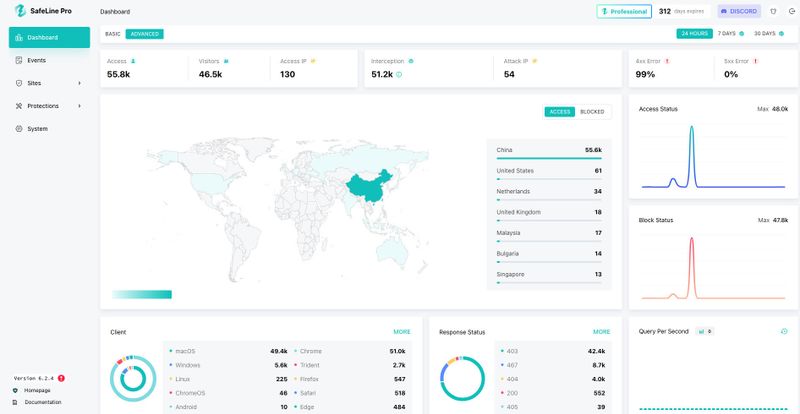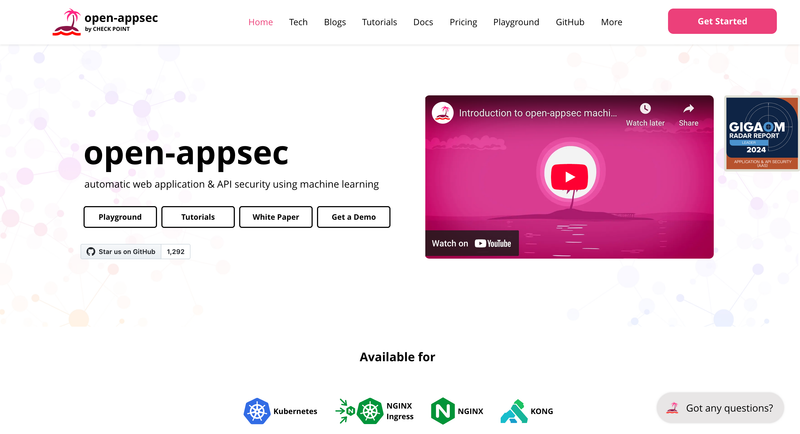Open source Web Application Firewalls (WAFs) are evolving fast—but not all are built the same. If you're comparing SafeLine and OpenAppSec, you're likely weighing two very different approaches to web security.
One is built around machine learning + Snort rules (OpenAppSec).
The other (SafeLine) takes a more advanced route: semantic analysis of traffic context, which doesn’t rely on signatures.
So which one actually protects your apps better?
Let’s break it down.
Detection Engine: Signatures vs. Semantics
| Feature | SafeLine | OpenAppSec |
|---|---|---|
| Detection Model | Intelligent semantic analysis engine | Rule-based Snort engine + ML suggestions |
| Traffic Understanding | Deep semantic parsing of HTTP requests | Signature matching + limited ML context |
| Zero-Day Handling | Resistant to obfuscation & unknown attacks | Relies on signature updates or custom tuning |
| False Positive Rate | Low (context-aware) | Moderate (depending on tuning and learning) |
SafeLine doesn't depend on regex or predefined rules. Instead, it analyzes the meaning of requests—detecting intent-based attacks even if payloads are heavily obfuscated.
OpenAppSec leans on Snort’s ruleset with a learning layer, which is effective, but still limited when dealing with novel or evasive attack patterns.
Feature Comparison
| Capability | SafeLine | OpenAppSec |
|---|---|---|
| SQLi/XSS/RCE Detection | ✅ Advanced | ✅ Rule-based |
| Dynamic JS & HTML Encryption | ✅ Yes | ❌ No |
| Bot & Scanner Mitigation | ✅ Yes (anti-automation engine) | ⚠️ Partial |
| Custom Rules | ✅ Yes | ✅ Yes |
| Cloud ML Support | ❌ Fully local, self-hosted | ✅ Requires cloud agent |
| Kubernetes Native | ✅ Yes (Helm, Ingress) | ✅ Yes |
| Integration | Nginx/OpenResty native module | Istio/Envoy/Nginx (via reverse proxy) |
Performance & Deployment
SafeLine is a self-hosted, high-performance WAF built on Nginx. It can run as a reverse proxy or transparent proxy, and integrates directly via module (not as a sidecar or traffic redirect).
OpenAppSec is typically deployed with reverse proxy modes (Nginx or Envoy), and may introduce extra complexity due to cloud dependencies or traffic redirection.
Philosophy: Detection Depth vs. Deployment Reach
OpenAppSec focuses on broad compatibility and quick starts. Its ML model tries to learn from traffic over time, but it still needs rules and signatures to stay effective.
SafeLine, on the other hand, is focused on precision detection. It’s designed to operate in high-security production environments where subtle evasion, automation, or logic abuse must be blocked—without constant manual rule updates.
Real-World Use Cases
-
Use OpenAppSec if you:
- Want a cloud-managed WAF with minimal setup
- Prefer Snort rules and existing threat feeds
- Are focused on sidecar or service-mesh deployments
-
Use SafeLine if you:
- Need deep semantic inspection and anti-obfuscation
- Want full control in a self-hosted WAF
- Need to block advanced bots, zero-days, or logic attacks
Resources
Final Verdict
If you’re looking for a smarter, self-hosted WAF that can keep up with modern attack patterns without chasing rule updates, SafeLine is worth a serious look.
It’s not just another ruleset—it’s a different level of traffic understanding.





Top comments (0)